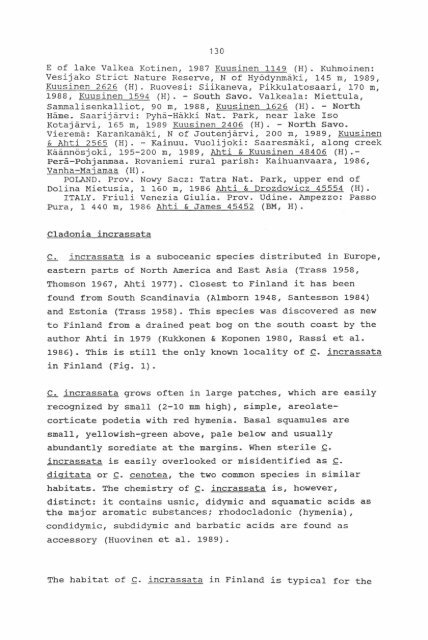Create successful ePaper yourself
Turn your PDF publications into a flip-book with our unique Google optimized e-Paper software.
130<br />
E of lake Valkea Kotinen, L9B7 Kuusinen 1149 (H) . Kuhmoinen:<br />
Vesijako Strict Nature Resenre, N of Hyodynrniki , L45 m, L989,<br />
Kuusinen 2626 (H). Ruovesi: Siikaneva, Pikkulatosaari, L7O m,<br />
1988 , Kuusinen 1594 (H) . Souttr Savo. Va1keala: Miettula,<br />
Sammalisenkalliot, 90 m, L988 , Kuusinen 162 6 (H) . North<br />
Hime. Saarijiinri: grhd-Hakki Nat. Park, near lake Iso<br />
Kotajinri, 155 m, 1989 Kuusinen 24O6 (H) . North Savo.<br />
Vieremii: Karankamdki, N of Joutenj rini , 2oO m, L989 , Kuusinen<br />
& Ahti 2565 (H). Kainuu. Vuolijoki: Saaresmiki, along creek<br />
Kiannosjoki , L95-200 m, 1989, Atrti & Kuusinen 48405 (H) . -<br />
Peri-Pohjanmaa. Rovaniemi rural parish: Kaihuanvaara, L986,<br />
Vanha-Mar amaa (H) .<br />
POLAND. Prov. Nowy Sacz: Tatra Nat. Park, upper end of<br />
Dolina Mietusia, 1 160 m, l-986 Atrti & Drozdowicz 45554 (H) .<br />
ITALY. Friuli Venezia Giulia. Prov. Udine. Ampezzo3 Passo<br />
Pura, 1 44O m, 1986 Ahti & James 45452 (BM, H).<br />
Cladonia incrassata<br />
e. incrassata is a suboceanic species distributed in Burope,<br />
eastern parts of North Anerica and East Asia (Trass l-958,<br />
Thomson L967, Ahti L977) . Closest to Finland it has been<br />
found from South Scandinavia (Alnborn 1948, Santesson 1984)<br />
and Estonia (Trass 1958 ) . This species rtas discovered as new<br />
to Finland from a drained peat bog on the south coast by the<br />
author Ahti in L979 (Kulckonen & Koponen L980, Rassi et al-.<br />
1986). This is still the only known locality of g. incrassata<br />
in Finland (Fig. 1) .<br />
C. -incrassata grows often in large patch€sr which are easily<br />
recogrnized by small (2-10 nm high), simple, areolatecorticate<br />
podetia with red hlmenia. Basal sqfuamules are<br />
small, yellowish-green above, pale below and usually<br />
abundantly sorediate at the margins. When sterile g.<br />
incrassata is easily overlooked or misidentified aq g.<br />
digitata or g. cenotea, the two conmon species in similar<br />
habitats. The chemist<strong>ry</strong> of g. incrassata is, howev€Er<br />
distinct: it contains usnic, didlmic and sqluamatic acids as<br />
the major aromatic substances; rhodocladonic (hymenia),<br />
condidlmic, subdialmic and barbatic acids are f ound as<br />
accesso<strong>ry</strong> (Huovinen et al. 1989).<br />
The habitat of c. incrassata in Finland is typical for the

















